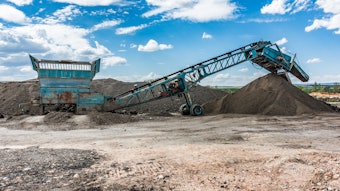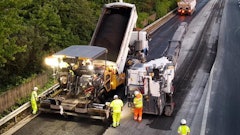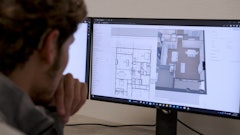
Sustainability is a critical concern for the construction industry, which generates more than 35% of global human-caused CO2 and consumes 40% of raw materials. With countries and organizations worldwide aiming for net-zero emissions, and green building codes being ushered in by municipalities, construction firms are now focused on enhancing their commitment to eco-friendly practices and waste reduction.
Automation innovations can address these sustainability challenges in many ways. Autonomous solutions improve building efficiency and decrease onsite worker time, reducing construction pollution. In fact, our research has found that progressive construction firms, which are defined as using four or more automated systems, are 58% more likely to experience sustainability improvements and waste reduction than their moderate counterparts.
However, while 34% of construction leaders surveyed in our recent report consider sustainability their top business priority within the next three to five years, it’s currently their lowest priority given macro headwinds shifting their near-term focus to the supply chain, increasing efficiency, and addressing labor shortages.
This delay is all too familiar – when business priorities compete, climate often gets the short straw, even if it creates long-term challenges. But we can’t afford to repeat the same mistakes in this downturn that were made as we entered 2008’s great recession. Cleantech was witnessing a boom ahead of that recessionary period, only to see its bubble burst as many industries (including construction) and investors quickly shifted away from capital-intensive and longer-term sustainability initiatives.
This time around, construction has a real opportunity to become a global leader in sustainability and show many other industries how investing in sustainability, even in a downturn, will produce significant advantages. Technology is the key. Here are three ways we need to use autonomous technology in building infrastructure and commercial and residential buildings today to address the climate crisis.
Empowering Sustainable Design
The idea that sustainable construction is a costly and impractical solution to ensure a return on a building is outdated and inaccurate. In fact, as green construction is increasingly automated, the upfront costs are being lowered, and payback is seen even earlier. According to the U.S. Green Building Council (USGBC), the initial cost of a green building is only 2%-3% higher than a typical building, and due to energy savings, they are 14% less costly to operate than traditional buildings.
The key to saving is implementing sustainability in construction projects from the beginning of the design process. Autonomous modeling and simulation tools can be used to identify issues in the design that could cause delays or inefficiencies throughout the build phase and empower engineers with data-driven workflows.
By putting data to work from the inception of a project, firms can also achieve more precise estimates and takeoffs. This directs them to order only the necessary materials, thereby minimizing the number of raw materials wasted. In addition, autonomy drives sustainable design and building by providing the insights necessary to prevent, identify, and correct wasteful practices and lower carbon footprints.
Utilizing a Digital Twin to Test Green Building
Building with a modular construction process and utilizing a digital twin, or a digital reflection of a physical building, provides autonomy to test and train sustainable construction and operations. It can assist in lowering CO2 emissions by prefabricating components and making them off-site in a controlled environment. It also reduces the amount of rework done on a project through real-time insights that are gained within its digital twin.
For instance, Prex, a sustainable builder in Japan, has used digital twin modeling to deliver more accessible and sustainable housing. By using this type of digital reality, Prex has developed new ways to model and deploy precast foundations, which can be constructed in a shorter time with fewer workers, reducing the project’s carbon output and safety hazards.
As ChatGPT continues to fuel the current artificial intelligence (AI) revolution in business, AI is also being integrated with building sensors to provide real-time information, recommendations, and autonomy with building operations. This combination allows those operating a building to understand the current state of the facility they are monitoring, discover potential challenges, and model how it could become more energy efficient.
Transforming the Way Dirt is Moved
While autonomous vehicles are poised to take over our roads in the years ahead, they’re already on the jobsite and moving us toward building more efficiently. Very shortly, we’ll see heavy construction vehicles that will be autonomous and electric – curbing the industry’s reliance on fossil fuels.
The opportunity for autonomous robots in construction goes far beyond self-driving trucks, bulldozers, and excavators, with autonomous data capture now being done with human-like robots or drones. These machines scan the construction site daily and upload data to identify any areas of concern, proactively address issues, and reduce — or even eliminate — the potential for future rework. Assigning robots to repetitive tasks can also improve efficiency, helping firms complete projects faster, freeing up skilled labor for other valuable tasks, and minimizing the need to have heavy equipment onsite longer — all reducing a project's carbon footprint. In fact, the construction industry leaders we’ve spoken to who use fully autonomous robotics emphasize their impact on improved sustainability and reduced waste.
Almost 38% of construction firms using fully autonomous robotics report that the most common benefit is improved sustainability. This is heavily linked to the ability to reduce resources needed, time, and budget, which are often the most significant problems on a majority of projects. By using autonomous technologies, construction firms can improve their sustainability efforts while increasing profitability — ultimately creating a win-win solution for the industry and the environment.



![Img 1707[56]](https://img.forconstructionpros.com/files/base/acbm/fcp/image/2023/04/IMG_1707_56_.6437076c97961.png?auto=format%2Ccompress&fit=crop&h=191&q=70&rect=0%2C462%2C1920%2C1080&w=340)


![Glp Porsche 072723 465 64ee42287c29e[1]](https://img.forconstructionpros.com/files/base/acbm/fcp/image/2024/03/GLP_PORSCHE_072723_465.64ee42287c29e_1_.65e88b8589b9c.png?auto=format%2Ccompress&fit=crop&h=135&q=70&rect=0%2C520%2C2250%2C1266&w=240)





















